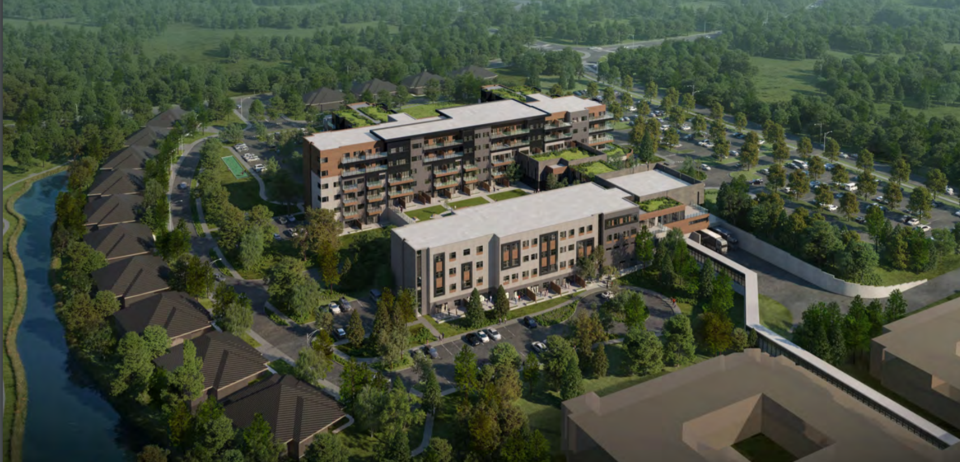COUNTY OF WELLINGTON – A proposed county-led seniors’ housing project on the county-owned Wellington Place campus is seen as a way to close a housing gap and offer seniors a chance to remain in their communities according to some members of county council.
Mary Lloyd, county councillor and chair of the IHS committee, said that based on a 2018 feasibility study of the COC that seniors’ housing options is lacking across the county.
She said at the time there were 586 long-term care beds in the county with an over 300 person waiting list.
There were also 856 retirement living spaces but income data showed some retirement spaces were unaffordable for many seniors.
“That’s only just gotten worse,” Lloyd said. “That was where we started and it’s just gone up more and more.”
The proposed housing community, called Continuum of Care (COC), has been designed with 254 units of attainable, market rental, retirement and life-lease housing geared towards a senior population that is expected to double in Wellington County over 25 years.
Included in the building are community hubs, commercial spaces and supportive services for an estimated cost of $135 million.
This design was presented to the information, heritage and seniors’ (IHS) committee on Oct. 14 to a mixed reception of support for improving seniors’ housing options, but also shock at the high-price point.
She said a survey of county seniors found that almost 70 per cent were considering moving out of Wellington County to access more seniors’ housing options.
Warden Kelly Linton said this was a driving reason behind this project.
“One of the stories I hear is seniors who have lived in our communities for all their lives, they can’t find a place to live when they want to downsize,” Linton said.
“They have to move to Kitchener-Waterloo or Guelph and that just doesn’t sit well with me.”
Linton said the private sector has not stepped up and the COC project can close that gap.
Lloyd explained that this is a benefit of the COC project as residents can move through different levels of care.
As an example, she said a 60-year-old couple might move in and be fully independent but can have increasing care needs as they age. This could be as simple as accessing a concierge service for food and laundry or a move to the retirement-living units for further care.
She also sees it as a way to keep couples together or closer than if one is in long-term care or retirement-living.
“The saddest story you hear now is one of the couples has moved into long-term care and the other partner is not able to continue to pay the rent they’ve been paying for years as a couple,” Lloyd said.
“The partner that is left in their home or apartment has lost basically half their income and can’t afford their apartment anymore.”
She said the COC can help with this because these couples have a place to downgrade their living space and therefore more easily afford it.
Lloyd explained that this can shift the county housing market which is short on available rental units and homes.
Eddie Alton, County of Wellington social services administrator, expanded on this, adding that in theory those who move to the COC will create openings in the wider housing market.
“Therefore this creates housing opportunities for individuals who are looking for a place to live, buy and represents a range of pricing and ownership opportunities,” Alton said via email. “This in turn frees up their current homes, therefore creates other opportunities along the housing continuum and so on.”
A sizable development like this is coming in at a high cost of $135 million and based on a report the county may have to take on nearly half as debt.
Linton said the reason it is this size is to have enough of a for-profit component to allow for the development of the 54 attainable priced units, which will be priced at about 70 per cent of market value.
“That provides a lot of the revenue needed to develop more of the attainable housing portion and the supportive housing portion of the project,” Linton said.
“We want to provide a cost-neutral project here and we don’t want to put too much county tax dollars to this project if it’s going to stop us from doing other really important projects.”
Lloyd said the next step of the project is to get the county council to approve the design and cost so they can explore government funding.
“Part of it is getting us to a point in the county where we have a … presentable item that says ‘We agree with this model to be built,’” Lloyd said. “Now we can go to the other levels of government and ask for help financially.”
This project has been in the pipeline for many years but Linton said this is because they needed to make sure the design would meet the needs of county seniors with an accurate estimated cost.
“We have the figures, the design and now we can move to the next stage and ask council if they want to move ahead,” Linton said.
There will be a special county council meeting on Thursday to discuss and make a decision on a recommendation to move forward with the project.
Lloyd stressed that this project won’t become any cheaper if they choose to wait.
“It’s never going to be cheap to do what’s right but at this point this is something that is right for the county,” Lloyd said.



